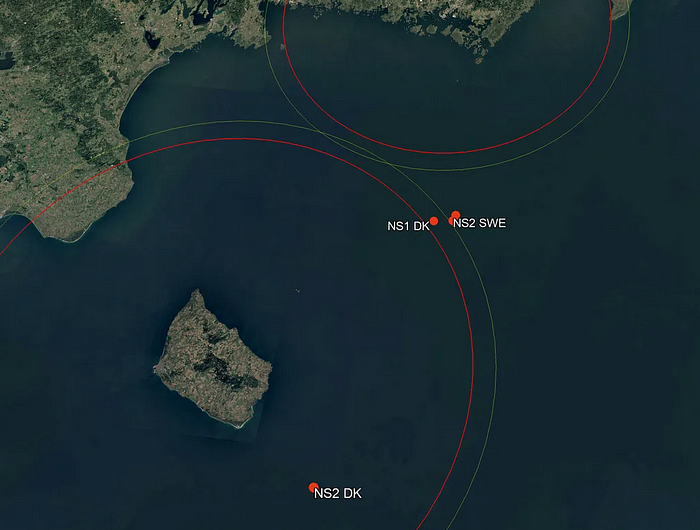Attack on Nord Stream: some puzzling questions

When bombers attacked the Nord Stream pipeline system last September they hit it at four points. The pipes, laid to supply Germany with natural gas from Russia, run for more than 1,200km beneath the Baltic Sea — which should have given the bombers plenty of options when deciding where to plant their explosives. However, there are a few puzzles regarding their eventual choice of locations.
German and Danish investigators suspect the explosives were placed by a group of six people aboard the Andromeda, a 15-metre yacht rented from a company in Rostock, Germany. The Andromeda left Rostock on September 7, returning a couple of weeks later. The explosions themselves occurred on September 26, several days after the Andromeda’s return.
For more background on the Nord Stream affair, including various theories about who was behind the attack, see my previous post.
According to German investigators the Andromeda group were using forged passports, so it’s safe to assume they were not on a legitimate sailing trip. Circumstantial evidence points more specifically to their involvement in the Nord Stream attack, though it is yet to be established whether they were in fact involved and, if so, whether they were acting alone.
Three of the four explosions were in a small area 50–60km northeast of the Danish island of Bornholm. The location is about 280km from Rostock as the crow flies, so if the group on the yacht were responsible for the attack they presumably had reasons for doing it there — reasons that made it worth sailing all the way from Rostock and back again.
Deep diving
The Andromeda group is said to have included two divers and two diving assistants. From a diver’s perspective, though, the chosen location was far from ideal because the water was almost 80m deep. Working at that depth would be a challenge, though probably feasible with the right training and equipment. However, there were plenty of other places closer to Rostock where the water was shallower and diving would have been easier.
The seabed contours can be seen in this map. (The map was published in a scientific study unrelated to Nord Stream, so the thicker lines are not relevant and can be ignored.)
Research by OSINT analyst Oliver Alexander indicates that the chosen site northeast of Bornholm was at the outer limits of Danish coastal radar, thus reducing the chances of the Andromeda’s activities being noticed. If that was an important consideration for the bombers, though, it makes the fourth explosion, south of Bornholm, more difficult to explain — because that was well within radar range.

Position of the pipes
Another possible factor in choosing a location was the arrangement of the underwater pipes northeast of Bornholm. This appears to have facilitated multiple attacks within a relatively small area.
The Nord Stream system has two pairs of pipes — NS-1 and NS-2 — making four pipes in all. In the location northeast of Bornholm the bombers managed to rupture both NS-1 pipes as well as one of the NS-2 pipes. It’s an area where the NS-1 and NS-2 pipes run side by side and fairly close together. In that respect, though, the chosen area was far from unique. NS-1 and NS-2 run in parallel along most of the Nord Stream route, including a section much closer to Rostock.
In comparison with the attacks northeast of Bornholm, the site of the isolated explosion reported 25km southeast of the island looks anomalous. Apart from being within radar range it was in an area where NS-1 and NS-2 follow separate courses. The explosion there hit one of the NS-2 pipes — the same pipe that was hit in the explosions further north — leaving the remaining NS-2 pipe intact.

A visit to Christiansø
The nearest land to the site of the three explosions is the Ertholmene archipelago, administered by the Danish defence ministry and regarded as a wildlife sanctuary. Its largest island — covering only 22 hectares and with fewer than 100 inhabitants — is Christiansø. In summer it’s often visited by day trippers who make the 20km crossing from Bornholm.
The Andromeda called at Christiansø during its voyage — which suggests the island’s proximity could have been a factor in choosing a location for the bombing. Exactly what the yacht crew were doing on the island remains to be seen. The innocent explanation is that they were picking up routine supplies but availability on Christiansø is limited and Bornholm, 20km further on, would seem a better option.
A question of boundaries
A further puzzle about the area of the three explosions is that it straddles a boundary between the Exclusive Economic Zone (EEZ) of Denmark and that of Sweden. One bomb exploded on the Danish side and two on the Swedish side — so the question is whether that was intentional.
Coastal states have sovereignty over the 12 miles of territorial waters adjacent to their shores. Beyond that is their EEZ which can extend for up to 200 miles. Within the EEZs each country has the right to manage and exploit natural resources in the water and below the seabed. These rights include environmental conservation activities as well as exploration for minerals conservation activities. The whole of the Baltic Sea is divided between the territorial waters of the surrounding countries and the relevant EEZs.
Starting at the German end of Nord Stream, the pipes pass through Germany’s territorial waters and its EEZ. On entering Denmark’s EEZ the pipes diverge. NS-1 then passes through Danish territorial waters around Bornholm, while NS-2 remains in the EEZ (where the fourth explosion occurred). The pipes converge again when they approach the Swedish EEZ.
It’s worth noting that none of the attacks occurred in territorial waters — which would almost certainly have been viewed as a direct attack on the country concerned. But in the EEZs the legal situation is rather vague and, according to one legal opinion, international law would probably classify the attack as a breach of the peace.
It seems likely, though, that the EEZ boundary between Denmark and Sweden was a factor in deciding where to place the explosives. It’s almost as if the bombers were making a conscious effort to involve both countries. But why they would want to do that is another puzzle.
Readers with any thoughts or further information are welcome to post comments here or send me a direct message on Twitter (@Brian_Whit).
For anyone who wants to look up the exact position of the explosions, these are the coordinates:
54°52.6′N 15°24.6′E
55°32.1′N 15°41.9′E
55°33.4′N 15°47.3′E
55°32.45′N 15°46.74′E
● CHECK HERE for regular updates about the Nord Stream affair
